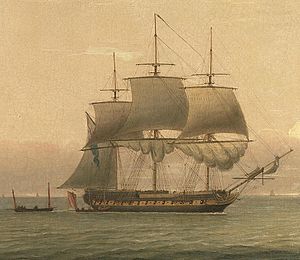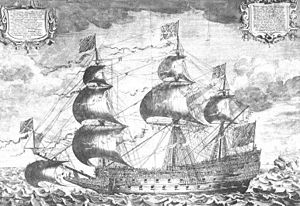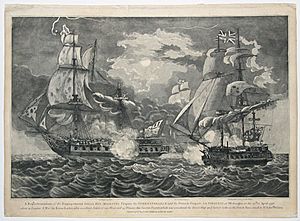Razee facts for kids
A razee (pronounced rah-ZEE) is a type of sailing ship that has been made smaller. This happens when parts of the ship, especially its upper decks, are cut down or removed. The word "razee" comes from the French phrase vaisseau rasé, which means a "shaved down" ship. Imagine trimming a tall bush to make it shorter and wider – that's kind of what happened to these ships!
Contents
Early Razee Ships (1600s)
In the 1600s, shipbuilders learned that making ships lighter at the top made them sail better. This was a time when ships were changing from older galleons to newer, faster warships called frigates.
For example, the famous ship Sovereign of the Seas was launched in 1637. It was later "cut down" to make it safer and faster. In 1651, even more of its cannons were removed to make it easier to steer.
Not just navies, but also pirates would razee their ships! A famous pirate writer, Charles Johnson, wrote about a pirate named George Lowther in 1721. Lowther changed his ship, Gambia Castle, by removing the cabins and making the deck flat. This made the ship much easier to handle because it had less wind resistance and was lighter overall.
Razee Ships in the 1700s and Early 1800s
The Royal Navy often took smaller two-deck ships of the line and turned them into razees. These older ships were not strong enough to fight in big fleet battles anymore, as newer, larger ships were being built.
When a ship of the line was razeed, it became a very strong frigate. These razeed frigates were usually much tougher than regular frigates built from scratch.
Sometimes, even bigger three-deck ships were razeed. They might have their top decks removed to become two-deckers, or just have their quarterdeck and forecastle removed.
Here are some examples of Royal Navy ships that were razeed:
- HMS Namur was a 90-gun ship launched in 1756. In 1805, it was razeed to become a 74-gun ship.
- Three 64-gun ships were cut down in 1794 to become 44-gun frigates. The most famous and successful of these was HMS Indefatigable, commanded by Sir Edward Pellew. The other two were HMS Magnanime and HMS Anson.
Later, during and after the Napoleonic Wars, many 74-gun ships were also razeed. Some became 58-gun ships, keeping two decks but losing their quarterdeck. Others were fully reduced to 50-gun heavy frigates.
French Razee Warships
The French navy also razeed some of their ships. Several 74-gun ships were changed into 54-gun ships during the Revolutionary War. For example, the Diadème was razeed and renamed Brutus.
United States Razee Warship
The United States also had a razee ship. The USS Independence, launched in 1814, was one such example.
Razee Ships in the Late 1800s
In the United States Navy, some of the last sailing frigates built in the 1840s were cut down to become large sloops-of-war.
During the 1850s, new technology allowed for much stronger guns that could fire heavier cannonballs and even exploding shells. So, when these frigates were updated with fewer, but much more powerful, guns, they needed fewer crew members. This made it possible to razee them.
Even though these ships carried fewer guns, their new, heavier cannons meant they could fire a stronger attack than they did as frigates. Their design and size also made them excellent sailing ships. Examples include USS Macedonian and USS Cumberland.




